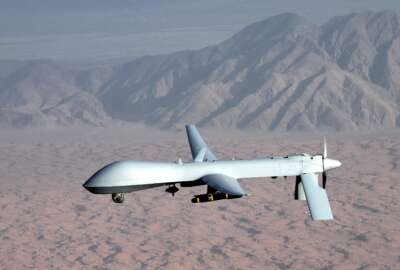The Air Force is set to begin training some of its enlisted members to fly aircraft next month — the first time it’s done so since it became a separate military service in 1947.
The first group of non-commissioned officers, which the Air Force is using as one of its answers to an overworked, understaffed cadre of unmanned aircraft pilots, will be brought in under a slow, cautious approach. The initial class will be made up of just four students, all of whom have experience as sensor operators or with some other aspect of the unarmed RQ-4 Global Hawk, the only platform the Air Force is allowing enlisted pilots to fly.
Two more groups of four airmen each will begin the training in the following months, for a total of 12 enlisted pilots in the Enlisted Pilot Initial Class (EPIC) program.
Lt. Gen. Darryl Roberson, the commander of Air Education and Training Command, said Monday that at least at the outset, the training would be identical to what its officer pilots in the remotely piloted aircraft (RPA) community receive 6-7 months of instruction at Joint Base San Antonio followed by 4-5 months at a formal training unit.
“Following the beta test of this initial class, we’ll make any adjustments that we see are necessary before we start the real, full-up RPA program for our enlisted force,” he told reporters at the Air Force Association’s annual conference in National Harbor, Maryland. “All four of our very first class are already very familiar with RPA operations. But by the time we get to the 12th airman in these classes, we are bringing in someone who has never been exposed to this so we can see the full gamut of folks — from those who are already highly propensed to RPAs all the way to somebody who has no clue, to see how each of them do. At the end of these three classes, we’ll do an assessment of what we saw and whether changes need to be made.”
As another part of the Air Force’s “get well” plan for its community of unmanned aircraft pilots, its secretary and chief of staff also ordered Roberson’s command to double the number of officers it trains each year. AETC officials said Monday they’d succeeded in doing that, having grown the pipeline from 192 pilots per year to 384 in 2016. The Air Force also said last month that it would offer retention bonuses of $35,000 to entice its existing drone pilots to stay in the military.
With regard to the Air Force’s shortage of qualified fighter jet pilots — a problem Gen. David Goldfein, its chief of staff, called a “crisis” last month — AETC officials said they had begun to take several steps to train new pilots to replace those the Air Force is losing to the commercial airline industry.
For example, two former F-16 squadrons at Hill Air Force Base that had been scheduled to be farmed out to various active and reserve commands will instead be dedicated to AETC as training units.
“But this is a multi-tiered effort,” said Brig. Gen. Andrew Croft, AETC’s director of plans, programs, resources and requirements. “We’re increasing our pilot production to 1,375 pilots a year — that’s about a 15 to 20 percent increase. We’re also increasing the number of pilots we put through the T-38 track, which allows us to make them fighter pilots or, in the future, pull them back into the fighter community. And at fighter formal training units, we’re going to increase the percentage of fighter pilot production between 10-20 percent, right away, across the board. That’s all happening right now and it’s going to scale up over time.”
Copyright
© 2024 Federal News Network. All rights reserved. This website is not intended for users located within the European Economic Area.
